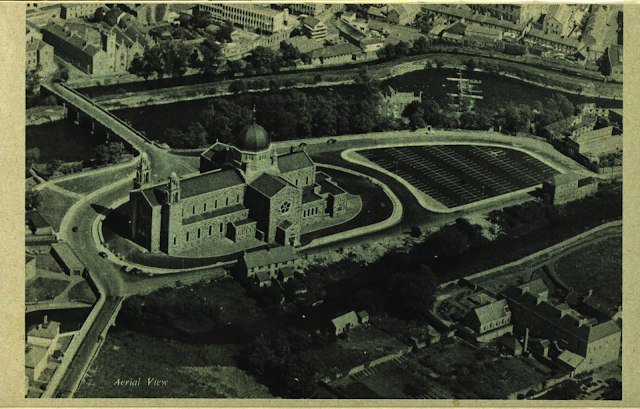History and significance of the Galway Cathedral (1967)
The Library has previously digitally published two booklets online which provide detail on the history and the construction of the Galway Cathedral. First published in 1967, these two booklets were digitised and published online by the Library a few years ago.
At this time of the year we are reminded of the history and significance of this iconic building in Galway. You can read the booklets in full detail on the Library's digital repository.
The first booklet was written by then Bishop of Galway, Michael Browne. The Bishop wrote this booklet as a response to requests from visitors to the Cathedral and also people from regular mass-goers from Galway. The booklet provides a short historical account showing how the dioceses of Galway, Kilmacduagh and Kilfenora came together, how the project of a Cathedral was initiated and developed, and how eventually the work was completed on August 15, 1965. Next there is a section explaining the architectural design and the motives which inspired it.
The second booklet provides a general overview of the function and purpose of a Catholic Cathedral, the history of the grounds of the Galway Cathedral, and also the plans and drawings of the Cathedral.
Browne also writes: "I can only hope that this booklet will fulfil a need, not merely as a description of the Cathedral, but also as a record of what several generations of Catholics tried to achieve in Galway for the glory of God. It should have been written sooner, but attendance at the Vatican Council and other duties delayed it."
The booklet also provides some images, including one of the gate of the old jail that was on the site. Outlined in the booklet is how in 1802, English parliament went about building a "new Gaol for the County of Galway". By 1810 the county and town had two jails built on a three acre site on Nuns' Island.
The booklet also refers to the fact that some famous prisoners were held in the jail on Nuns' Island, one of whom was William O'Brien, who was a leader of the Land League and was detained in 1889.
Within a few years of Irish Independence being established, prisoner numbers dwindled and the government decided there would no longer be a need for a prison in the town. The site was acquired by the then Bishop of Galway as the location for a cathedral to be built. Noted in the booklet is how "English parliament in 1802 little thought that it's jail would give place place to a cathedral of the religion of the people then so completely conquered. There can be no greater monument to the resurrection of the Irish nation than the building of a cathedral on this spot."
 |
| The old jail |
The construction of the cathedral began in February 1958, with the digging of the foundations. The booklet outlines how "Rock-solid green granite was found a few feet under the surface. The building of the walls went ahead without any untoward incident. There was no strike; and there was no accident, though as the walls rose the men had to work at great heights, without shelter from rain or cold. The time provided for completion of the contract was six years, so that the work should have been finished in February 1964, but there came one prolonged period of sharp frost when no work could be done during the months of January and February 1963."
It states how steady progress was, however, made and a tribute is given to the foreman, Mr. Lillis, and to the workers for the "energy and devotion which they gave to the work".
 |
| The builders |
The third section of the first booklet, the description of the Cathedral, is intended to be read as one walks around the exterior and the interior. This description would still be useful today if one wanted to take a walk around the grounds of the Cathedral.
This blog is just a selection of some of the content within these booklets and we would encourage you to take a deeper look for yourself.
 |
| Aerial view of the early Galway Cathedral |

Comments